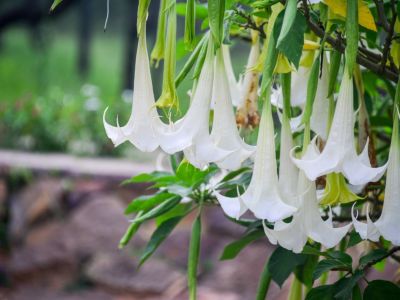Disease Problems of Brugmansia
Understanding the pathogen is the best way to get started with diseased brugmansia care. Although this list is far from exhaustive, being able to recognize these common brugmansia diseases will help you make the right care decisions for your plant: Bacterial Leaf Spot – Caused by the bacteria Xanthomonas campestris pv. hederae, bacterial leaf spot is encouraged by high humidity. It appears as a series of small, brown spots surrounded by a yellow halo and can spread rapidly. When it appears, thin your plants to increase air circulation, clean up any fallen plant debris and remove all affected leaves to slow or stop the infection. Downy Mildew – This common fungal disease is caused by a number of fungal pathogens, but it always appears similarly. When you notice irregular yellow spots on the tops of your plant’s leaves and a webby or cottony growth on the underside, you’ve got downy mildew. You can treat it easily with neem oil, applied to both sides of the leaves at 7- to 14-day intervals for several weeks. Powdery Mildew – Powdery mildew is very similar to downy mildew and is treated in the same way. Instead of the fungal mass being on the underside of the leaf though, a powdery, mealy substance appears on the top of the leaf. Both diseases can be deadly if left untreated and plants may benefit from a reduction in the humidity level. Root Rot – Common soil fungi, like Pythium, are responsible for destroying the roots of brugmansia when the soil has remained waterlogged for an extended period. Sick plants will wilt readily and may appear less vigorous, but you won’t know for certain you’ve got root rot unless you dig your plant up and check the roots. Black, brown, or soft roots, or those whose sheaths slide off readily, are already dead or dying. You can sometimes save these plants by repotting them in dry soil with excellent drainage and watering them well. Never leave a plant in standing water, as this only encourages root rot. Verticillium Wilt – A devastating and all-too-common problem, verticillium wilt is the result of a pathogenic fungus that enters the affected brugmansia’s transport tissues through the root system and rapidly multiplies. Plants typically will die in sections, with yellow leaves appearing all along one stem early in the disease. As it spreads, more of the plant wilts and drops. There is no cure for verticillium wilt, but planting future brugmansia in sterile soil can help to prevent it from taking hold. Viruses – Tobacco mosaic and tomato spotted wilt viruses are the most common viruses among brugmansia. Tobacco mosaic causes a distinctive mosaic pattern of yellow and green areas on the leaf, along with deformed fruits and flowers. Tomato spotted wilt stunts plant growth and causes brown to black streaking on stems, as well as leaf deformity and yellow veins. Unfortunately, viruses are for life in plants. All you can do is destroy the infected brugmansia to prevent from spreading the disease to nearby plants.
